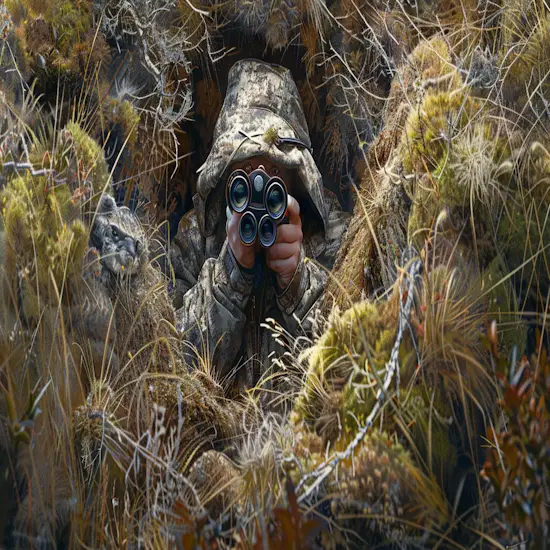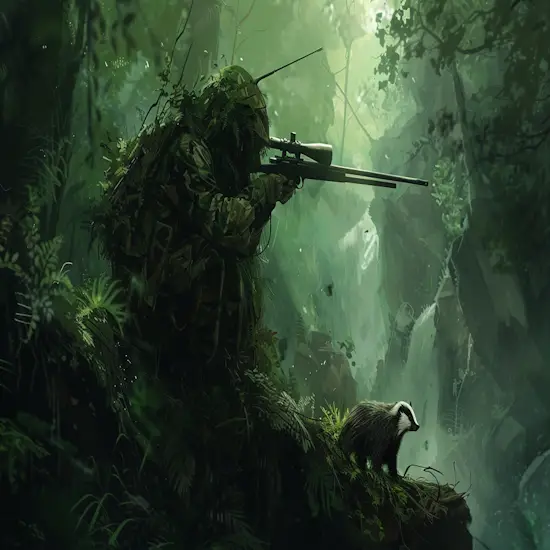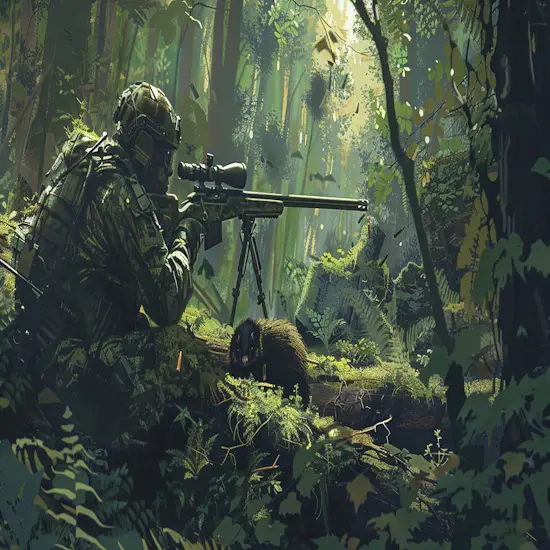Disclosure: We may earn commissions if you purchase products after clicking on a link from our site.
If you’re looking to hunt badgers, consider this scenario: Imagine you’re in a vast grassland, equipped with knowledge about their nocturnal habits and favored habitats. Understanding their routines could be the key to a successful hunt. But that’s just the beginning. As you navigate the world of licenses, permits, and regulations, there’s much more to explore. Stay tuned to discover the essential strategies and safety measures that can make your badger hunting experience both rewarding and responsible.

Table of Contents
- 1 Key Takeaways
- 2 Understanding Badger Behavior
- 3 Licensing and Permits
- 4 Hunting Laws and Regulations
- 5 Hunting Techniques
- 6 Scouting and Tracking
- 7 Hunting License
- 8 Public Land Hunting
- 9 Private Land Hunting
- 10 Ethical Hunting
- 11 Badger Hunting Gear
- 12 How to Hunt Badgers Without a Gun
- 13 How to Hunt Badgers in the Winter
- 14 How to Hunt Badgers in California
- 15 What Do Badgers Eat?
- 16 Badger Hunting Season
- 17 Can You Hunt Badgers in Wisconsin?
- 18 Safety Measures
- 19 How to Attract Badgers
- 20 The Bottom Line
Key Takeaways
- Obtain necessary licenses and permits, ensuring compliance with local hunting regulations.
- Scout for badger habitats in open grasslands or thick cover on public lands.
- Utilize nocturnal activity knowledge for hunting success during nighttime hours.
- Follow ethical hunting practices and techniques to contribute to conservation efforts.
- Prioritize safety with appropriate gear, firearm handling, and environmental awareness.

Understanding Badger Behavior
To successfully hunt badgers, it’s important to understand their behaviors. Badgers exhibit territorial tendencies and prefer habitats like open grasslands. Knowing their feeding patterns and nocturnal activities can greatly enhance your hunting strategies.
Badger Habits
Understanding badger behavior is essential for successful hunting strategies. Badgers are nocturnal creatures, meaning they’re most active at night for foraging and social interactions. During the day, they prefer to stay inside their extensive tunnel networks called setts, emerging only at night.
Badgers are territorial animals, establishing setts in open grasslands and farmlands. They exhibit aggressive behavior when defending their territories or young, making it important to approach with caution during hunting. Badgers are opportunistic feeders, consuming earthworms, insects, and small mammals, with earthworms being a significant part of their diet. Their feeding habits vary seasonally based on food availability.
Understanding these habits can help hunters anticipate their movements and plan effective hunting strategies. By studying badger behavior, hunters can increase their chances of a successful hunt by positioning themselves strategically during the nocturnal hours when badgers are most active.
Badger Habitats
Where do badgers prefer to establish their territories and setts?
Badgers are creatures of habit, favoring open grasslands and farmlands for their territories. These areas provide the essential conditions for their extensive tunnel networks, known as setts. Setts are vital to badgers, serving as their homes where they sleep, rear their young, and seek refuge from predators. The open grasslands and woods edges offer the perfect combination of shelter and food sources for these territorial animals.
In these habitats, badgers can efficiently hunt earthworms, insects, and small mammals, which make up a significant portion of their diet. Their territorial behavior is closely linked to these food sources’ availability, influencing their territories’ size.
Feeding Patterns
Badgers’ feeding patterns are influenced by their opportunistic nature and the availability of earthworms, insects, and small mammals in their habitats. These creatures have a diverse diet, adapting to what’s accessible. Earthworms are a significant part of their food source, making up a substantial portion of their meals.
Badgers are known for their ability to dig and hunt underground prey, such as insects and small mammals like rodents. Their feeding habits can vary seasonally, with preferences for open grasslands and wooded areas where they can easily find their prey. Additionally, badgers create intricate tunnel systems called setts, which serve as their homes and provide safety from predators while also aiding in their hunting endeavors.
Nocturnal Activities
To successfully hunt badgers, familiarize yourself with their nocturnal activities. Badgers are primarily active at night, making it important to understand their nighttime behaviors. These creatures spend their nights foraging for food, marking territories, and engaging in social interactions. During the day, badgers stay inside their setts, intricate tunnel networks where they rest and shelter. Knowing these nocturnal patterns is essential for planning your hunting strategy.
When hunting badgers, consider that their nocturnal habits influence when and where they’re most likely to be active. By being aware of their preference for nighttime activities, such as marking territory, you can increase your chances of a successful hunt. Setting up near areas where badgers are likely to forage during the night can improve your hunting opportunities.

Licensing and Permits
Make sure you obtain the necessary licensing and permits before starting your badger hunting expedition. It is vital to abide by regulations and have the appropriate documentation. Here is a table outlining some key points regarding licensing and permits:
| Licensing and Permits | Description | Importance |
|---|---|---|
| Hunting License | Required for legal hunting activities. | Ensures compliance with state regulations. |
| Special Permits | Sometimes needed for hunting specific species. | Allows for targeted hunting permissions. |
| Landowner Permission | Essential if hunting on private properties. | Shows respect for landowner rights. |
| State Regulations | Must be followed for hunting legality. | Prevents legal issues and penalties. |
| Bag Limits | Restrictions on the number of animals hunted. | Maintains wildlife population sustainability. |
Ensuring you have the proper licensing and permits will not only keep you on the right side of the law but also contribute to sustainable hunting practices.

Hunting Laws and Regulations
You must always follow local hunting laws and regulations when hunting badgers. Be aware of the hunting seasons, bag limits, designated hunting zones, and legal hunting hours. It’s essential to obtain proper hunter education and licenses before heading out to hunt.
Seasons
Understanding the hunting laws and regulations concerning seasons is essential before engaging in badger hunting. Badgers have specific seasons during which hunting is permitted, and it’s vital to adhere to these guidelines to guarantee ethical and legal hunting practices.
In many regions, badger hunting is regulated to protect the population and prevent overhunting. Typically, badger hunting seasons coincide with times when badgers are most active and their populations are stable. It’s important to check with local wildlife authorities to determine the exact dates of the hunting season in your area.
During the hunting season, badgers may exhibit different behaviors based on factors like mating, territorial disputes, and food availability. Understanding these seasonal patterns can greatly impact the success of your hunting expedition. By being aware of the hunting season and how it influences badger behavior, you can plan your hunting tactics effectively and increase your chances of a successful hunt.
Bag Limits
As you continue your preparations for badger hunting, it’s important to be aware of the bag limits set by hunting laws and regulations. Bag limits are restrictions on the number of badgers you are allowed to harvest during a specific time period. These limits are put in place to guarantee the conservation of badger populations and sustainable hunting practices.
To give you a clearer understanding, here is a breakdown of bag limits in different states:
| State | Bag Limit | Season Dates | Hunting Hours |
|---|---|---|---|
| Kansas | 1 per day | Nov 1 – Jan 31 | 1 hour before sunrise to 1 hour after sunset |
| Texas | 2 per season | Sept 1 – Dec 31 | No restrictions |
| California | 1 per season | Oct 15 – Mar 15 | Daylight hours only |
Make sure to check the specific regulations in your hunting area, as bag limits can vary by state and even by region within a state. Always hunt responsibly and within legal limits to help conserve badger populations for future generations.
Hunting Zones
To understand hunting zones for badgers, familiarize yourself with the local laws and regulations in your hunting area. Complying with these rules is vital to guarantee a successful and legal hunting experience.
Knowing designated hunting zones is essential as it dictates where you can pursue badgers within legal boundaries. Each area may have specific restrictions or permissions, so be diligent in researching and understanding these details before setting out.
Public lands often offer diverse terrains for hunting, ranging from forests to grasslands. Look for areas with thick cover where badgers are likely to frequent. It’s important to adapt your gear according to the environment you’ll be hunting in.
Remember to seek permission from landowners before hunting on private property, and consider controlled environments on private lands for potentially better hunting opportunities.
Hunting Hours
Familiarize yourself with the hunting hours specified in local regulations to guarantee compliance and legality when hunting badgers. It’s crucial to know when you can legally pursue these animals. Typically, badger hunting is allowed during specific hours of the day to uphold conservation and safety. Hunting outside of these designated hours may result in penalties or fines.
Local hunting laws often restrict badger hunting to certain times to prevent overhunting and disturbance to wildlife populations. By adhering to these regulations, you contribute to the preservation of the ecosystem and respect the natural behavior of badgers. Additionally, hunting during the permitted hours increases your chances of a successful hunt since badgers are more active during specific periods, such as at night.
Before heading out, familiarize yourself with the specific hunting hours set by local authorities. It’s your responsibility as a hunter to follow these guidelines to maintain the integrity of the sport and protect the wildlife you seek to hunt.
Hunter Education
Learning about hunting laws and regulations is vital for all hunters, guaranteeing compliance and ethical behavior in the field. By educating yourself on the specific laws in your area, you can avoid legal issues and contribute to wildlife conservation efforts.
Before heading out to hunt badgers, make sure you’re familiar with the hunting seasons, bag limits, designated hunting zones, and legal hunting hours. Obtaining a hunting license is an essential requirement that you shouldn’t overlook.
Remember to adapt your gear to different environments, and always seek permission from landowners before hunting on private lands. Public lands provide diverse terrains for hunting, but ensure you follow the rules and regulations set forth by the governing authorities.
Equipment Regulations
How do hunting regulations impact the equipment you can use when hunting badgers?
When it comes to hunting badgers, it’s essential to follow specific equipment regulations set by local hunting laws. These regulations are in place to guarantee the safety of both hunters and the wildlife being pursued. The gear you use must comply with these rules, which can include restrictions on firearm types, ammunition sizes, and hunting methods. Make sure to check the legal requirements for hunting badgers in your area before heading out to ensure you’re using the appropriate equipment.
Additionally, some regulations may dictate the use of specific tools or techniques to prevent unnecessary harm to the badgers or their habitats. By adhering to these equipment regulations, you contribute to the conservation efforts and help maintain the balance of the ecosystem.
Always remember that following the rules not only keeps you on the right side of the law but also promotes ethical and responsible hunting practices.
Ethical Hunting Practices
Check local hunting laws and regulations to confirm compliance with ethical hunting practices. It’s essential to be aware of the rules governing hunting activities in your area to verify you’re conducting yourself in a responsible and ethical manner.
By following these regulations, you contribute to the conservation of wildlife populations and habitats, as well as promote safe and sustainable hunting practices. Make sure to obtain the necessary permits and licenses before heading out on your hunting expedition.
Understand the designated hunting zones and legal hunting hours to avoid any violations. Adhering to hunting seasons and bag limits helps maintain a balanced ecosystem and prevents overexploitation of animal populations.
Remember to respect private property rights and seek permission from landowners before entering any hunting grounds. By abiding by these laws and regulations, you demonstrate your commitment to ethical hunting practices and contribute to the preservation of our natural environment.

Hunting Techniques
To effectively hunt badgers, you should be aware of various techniques. Spot and stalk involve locating the badger and then closing in for the kill. Baiting, trapping, and using dogs, calls, and decoys are other methods that can be utilized for a successful hunt.
Spot and Stalk
Spot and Stalk hunting technique involves silently approaching your target by locating it from a distance and moving in for a close shot. To effectively utilize this method, you must first spot your prey and then carefully stalk it to get within shooting range. Here’s a simple breakdown to help you understand the Spot and Stalk technique:
| Step | Description | Tip |
|---|---|---|
| Spotting | Locate the badger from a distance using binoculars or a spotting scope. | Look for movement or signs of digging near sets. |
| Stalking | Move quietly towards the badger, utilizing cover and terrain for concealment. | Keep the wind in your favor to avoid being detected. |
| Shooting | Once within range, take a steady aim and shoot accurately. | Aim for critical areas to ensure a quick and ethical kill. |
Baiting
Locate potential badger hunting locations near setts for effective baiting. Badgers are attracted to food sources like earthworms and insects, making baiting a viable technique. Place bait such as meat scraps, peanuts, or canned cat food near badger setts during the evening hours when they’re most active.
Make sure the bait is securely positioned to prevent other animals from taking it. Consider using bait stations or bait piles to concentrate badgers in specific areas.
Monitor the bait regularly and adjust the placement if needed. Remember, badgers are cautious animals, so it may take time for them to feel comfortable approaching the bait. Be patient and avoid disturbing the area unnecessarily.
Once badgers start feeding on the bait consistently, you can plan your hunting approach accordingly. Baiting can be an effective way to draw badgers out of their setts and increase your chances of a successful hunt.
Trapping
When trapping badgers, make sure you have the appropriate equipment and knowledge of their behaviors. Here are some key points to keep in mind:
- Choose the Right Trap: Select a trap suitable for badgers, like a cage trap or a leg-hold trap. Make certain the trap is sturdy and humane to prevent harm to the animal.
- Proper Placement: Position the trap near known badger paths or setts, ensuring it’s well camouflaged to avoid detection. Badgers are cautious creatures, so strategic placement is essential.
- Baiting Techniques: Use enticing baits like earthworms, insects, or meat to lure badgers into the trap. Place the bait at the back of the trap to ensure the badger fully enters the trap before triggering it.
- Regular Monitoring: Check the trap frequently to prevent the animal from suffering for extended periods. Once trapped, handle the situation swiftly and with care to release the badger unharmed or to humanely dispatch it if necessary.
Use of Dogs
To enhance your badger hunting experience, consider incorporating trained dogs to assist in tracking and locating these elusive creatures. Dogs can be valuable allies in the hunt, using their keen sense of smell and tracking abilities to lead you to badger sets. Breeds like terriers or dachshunds are often used for their expertise in locating underground prey.
When using dogs for badger hunting, make sure they’re well-trained to follow your commands and work efficiently in the field. Start by introducing them to the scent of badgers and teaching them to indicate when they’ve found a sett.
Once they locate a sett, the dogs can help flush out the badgers for a potential shot. Remember to prioritize the safety and well-being of both the dogs and the badgers during the hunt. Proper training, equipment, and supervision are essential to make the most of this hunting technique. With skilled dogs by your side, your chances of a successful badger hunt increase considerably.
Calls and Decoys
Using calls and decoys is essential for enhancing your hunting tactics when pursuing badgers in the wild. Here’s how you can effectively incorporate calls and decoys into your badger hunting strategy:
- Choose the Right Calls: Select electronic or mouth calls that imitate prey sounds like distress calls or rodent squeaks. Match the call to the season for maximum effectiveness.
- Utilize Decoys: Combine calls with decoys to lure badgers out. Decoys can be visual aids mimicking movement or even scent markers to attract badgers.
- Understand Nocturnal Patterns: Since badgers are primarily nocturnal, plan your hunting trips accordingly. They’re most active at night, foraging outside their setts.
- Patience and Observation: Use calls and decoys strategically, and be patient. Badgers are cautious animals, so observe their responses and adjust your tactics accordingly.

Scouting and Tracking
Regularly scouting and tracking badgers in their natural habitats is essential for successful hunting expeditions. To effectively scout and track badgers, it is important to understand their behaviors and preferred habitats. Badgers are territorial animals that prefer open grasslands and farmlands, where they establish extensive tunnel networks called setts for shelter and breeding.
| Scouting Tips | Tracking Techniques |
|---|---|
| Look for sett entrances. | Follow fresh claw marks. |
| Search for foraging areas. | Look for disturbed earth. |
| Check near water sources. | Look for tracks and scat. |
Scouting involves looking for sett entrances, foraging areas, and near water sources. Pay attention to signs like fresh claw marks, disturbed earth, tracks, and scat. When tracking, follow these signs to locate the badgers. Remember to be patient and observant while scouting and tracking, as badgers are primarily nocturnal and may be more active during the night.

Hunting License
You need a valid hunting license before pursuing badgers legally. Make sure you have the necessary paperwork in order to avoid legal repercussions.
Here’s what you need to take into account when it comes to hunting licenses:
- Check Your State Regulations: Different states have varying requirements for hunting licenses. Be certain you’re familiar with the specific rules in your area.
- Understand License Types: There may be different types of hunting licenses available, such as resident, non-resident, or youth licenses. Choose the one that applies to you.
- Renewal and Expiration: Keep track of when your hunting license expires and make sure to renew it in a timely manner to avoid interruptions in your hunting activities.
- Carry It With You: Once you have your hunting license, remember to carry it with you at all times while hunting. It serves as proof that you’re hunting legally.

Public Land Hunting
For public land hunting, familiarize yourself with designated hunting zones and regulations before venturing out. Make sure to adhere to all local hunting laws and understand the hunting seasons and bag limits.
Public lands provide diverse terrains ranging from forests to grasslands, so look for thick cover areas where badgers might reside. States typically offer maps of public hunting lands for your reference. It’s crucial to adapt your gear to different environments you may encounter while hunting on public lands.
When hunting on public lands, remember to be aware of legal hunting hours and make sure you have obtained the necessary hunting license before heading out. Seek permission from landowners if required, and always respect the rules and regulations set forth for hunting in these areas.
Public land hunting can offer unique challenges and opportunities, so be prepared and follow the guidelines to have a successful and enjoyable hunting experience.

Private Land Hunting
When hunting on private land, make sure you obtain permission from the landowner before proceeding. Hunting on private land offers unique opportunities for a successful badger hunt. Here’s what you need to know:
- Respect for the Land:
Always respect the landowner’s rules and regulations. Treat the land with care and leave it as you found it.
2. Communication is Key:
Communicate clearly with the landowner about your hunting plans and expectations. Establish a good relationship to guarantee future access.
3. Safety First:
Make sure you’re aware of any potential hazards on the property. Stay safe by using appropriate gear and following all safety protocols.
4. Gratitude:
Show gratitude towards the landowner for allowing you to hunt on their private property. A small gesture of appreciation can go a long way in maintaining a positive relationship.

Ethical Hunting
When hunting badgers, it’s important to prioritize ethical practices. Remember to hunt responsibly, using humane methods that prioritize the welfare of the animal.
Additionally, consider participating in conservation efforts to guarantee the sustainability of badger populations.
Responsible Hunting Practises
Adhere to ethical hunting practices to guarantee the humane and respectful treatment of wildlife during your hunting endeavors. It’s important to uphold these principles to safeguard the well-being of the animals and the environment.
Here’s how to practice responsible hunting:
- Respect Wildlife: Treat all animals with care and respect. Avoid causing unnecessary suffering or harm.
- Hunt Responsibly: Take only what you need and can use. Avoid wasteful practices and prioritize conservation.
- Follow Regulations: Adhere strictly to all hunting laws and regulations. Obtain the necessary permits and licenses before engaging in any hunting activities.
- Leave No Trace: Minimize your impact on the environment by cleaning up after yourself. Dispose of waste properly and leave the natural habitat undisturbed.
Humane Methods
Respecting wildlife and hunting responsibly are foundational aspects of ethical hunting, ensuring that humane methods are employed throughout the hunting process.
When hunting badgers, it’s vital to prioritize their well-being. Always aim for quick, clean kills to minimize suffering. Use proper ammunition and shot placement to guarantee a swift and humane end.
Additionally, consider the environment where the hunt takes place. Avoid causing unnecessary harm to other wildlife or habitats.
After a successful hunt, handle the animal with care and respect. Field dress the badger promptly to preserve the meat quality and prevent waste.
Remember that as a hunter, you play an important role in maintaining the balance of nature. By practicing humane hunting methods, you contribute to the conservation of wildlife populations and their habitats. Always approach hunting with a mindset of stewardship and respect for the animals you pursue.
Conservation Efforts
To support wildlife populations and habitats, prioritize conservation efforts while engaging in ethical hunting practices. Here are four key ways you can contribute to conservation while hunting badgers:
- Respect Wildlife Habitats: Be mindful of the environment and avoid disturbing natural habitats. Badgers play a vital role in ecosystems, so it’s imperative to protect their homes.
- Practice Sustainable Hunting: Follow regulations and hunting quotas to prevent overexploitation of badger populations. Sustainable hunting guarantees a balance between hunting activities and wildlife conservation.
- Support Conservation Organizations: Get involved with local conservation groups that work to protect wildlife and their habitats. Your contributions can make a difference in preserving biodiversity.
- Educate Others: Share your knowledge and passion for ethical hunting practices with fellow hunters and communities. By spreading awareness, you can inspire others to prioritize conservation efforts while enjoying the hunting experience.

Badger Hunting Gear
To pursue badgers, make sure you have the right gear suited for the task. Essential items include a sturdy rifle or shotgun for a clean kill, along with appropriate ammunition. Opt for a rifle with a caliber of .22 or larger, or a shotgun with buckshot or slugs.
A reliable flashlight or headlamp is essential for nighttime hunting when badgers are most active. Wear durable clothing and boots to navigate varying terrains and protect yourself from scrapes and bites. Gloves are necessary for handling the carcass.
A hunting knife for field dressing and skinning the badger is a must-have tool. Consider bringing a trapping cage if you prefer a non-lethal approach. Lastly, pack a first aid kit for emergencies.
With the right gear in hand, you’ll be better prepared to set out on a successful badger hunting expedition.

How to Hunt Badgers Without a Gun
If you find yourself without a gun while hunting badgers, consider utilizing alternative methods to achieve a successful hunt.
- Trapping: Set up traps near badger setts using bait like earthworms or small mammals. Check traps regularly to guarantee humane capture.
- Tracking and Snaring: Follow badger tracks to locate their dens. Use snares strategically placed near entrances to catch them.
- Hunting Dogs: Employ well-trained hunting dogs that can track and corner badgers without harming them. Use caution as badgers can be fierce.
- Stunning Devices: Utilize non-lethal stunning devices like tranquilizer darts to immobilize badgers for safe capture or relocation.
Remember to prioritize safety and ethical hunting practices when pursuing badgers without a gun. Understanding badger behavior and habitats will increase your chances of a successful hunt using these alternative methods.

How to Hunt Badgers in the Winter
When hunting badgers in the winter, adapt your strategies to the seasonal changes for increased success. During winter, badgers tend to have limited movements and stay denned during extreme cold. To hunt them effectively, focus on areas where badgers are more likely to be active despite the cold temperatures.
Look for signs of badger activity near their setts, such as fresh tracks in the snow leading to potential food sources. Since badgers are primarily nocturnal, plan your hunting trips accordingly, targeting early mornings or late evenings when they might be out foraging.
Utilize calls that imitate prey sounds to attract badgers out of their setts during the winter nights. Electronic or mouth calls can be effective, especially when combined with decoys to enhance their appeal. Consider setting up near known badger territories and patiently wait for their response to your calls.
Remember to dress warmly and be prepared for the winter conditions to make sure a comfortable and successful hunting experience in the cold.

How to Hunt Badgers in California
When hunting badgers in California, it is important to consider various aspects that can enhance your experience. First, ensure you are familiar with the local hunting regulations, including permits, licenses, hunting seasons, bag limits, and specific rules related to badger hunting.
Understanding the behavior of badgers is crucial for a successful hunt. In California, badgers are nocturnal and territorial animals that prefer open grasslands and farmlands where they create tunnel networks known as setts. Knowing these behaviors will help you effectively track and locate them during your hunting expeditions.
When scouting for badgers, focus on habitats that offer open grasslands and farmlands, as these are common areas where badgers are found. Keep an eye out for signs of tunneling and sett entrances, which are indicators of their presence in the vicinity.
To increase your chances of a successful hunt, equip yourself with the appropriate hunting gear suitable for California’s terrain. Consider using calls to mimic prey sounds and attract badgers towards you. By being prepared and knowledgeable about regulations, behaviors, habitats, and gear, you can significantly improve your badger hunting experience in California.

What Do Badgers Eat?
To understand the dietary habits of badgers, it’s important to explore what these creatures typically consume in their natural environment. Badgers primarily feed on earthworms, insects, and small mammals. They’re opportunistic eaters, meaning their diet varies based on food availability.
Earthworms are a significant part of their food source, and they rely on them for sustenance. The feeding habits of badgers change seasonally, and they prefer habitats with open grasslands and woods edges where they can find their preferred prey.
Additionally, badgers are known to dig tunnels and chambers known as setts, which they use for sleeping, rearing young, and escaping predators. Their territorial behavior is often based on the availability of food sources, and the size of their territory can fluctuate depending on the abundance of food in their environment.

Badger Hunting Season
During the badger hunting season, it’s important to be mindful of the specific regulations and guidelines in place to guarantee a safe and lawful hunting experience. Here are some essential considerations to keep in mind:
- Know the Laws: Make sure you’re well informed about the local hunting regulations and adhere strictly to them to avoid any legal complications.
- Understand Badger Behavior: Familiarize yourself with the habits and habitats of badgers to increase your chances of a successful hunt.
- Use Proper Gear: Select appropriate hunting gear that aligns with the hunting season and the terrain you’ll be exploring.
- Stay Safe: Prioritize safety by informing others of your hunting plans, carrying emergency supplies, and being cautious in the wilderness.

Can You Hunt Badgers in Wisconsin?
You can legally hunt badgers in Wisconsin with the appropriate permits and following state hunting regulations. Wisconsin allows hunting of badgers as long as hunters obtain the necessary licenses and adhere to the established guidelines.
Before setting out on a badger hunting expedition, make sure you familiarize yourself with the specific regulations in Wisconsin regarding bag limits, hunting seasons, and any designated zones where hunting is permitted.
It’s important to remember that hunting badgers requires a certain level of skill and understanding of their behaviors and habitats. Badgers are primarily nocturnal animals, so being aware of their patterns and activities during different times of the day can be essential for a successful hunt.
Ensure you have the proper hunting gear suited for badger hunting and always prioritize safety and ethical hunting practices while in the field.

Safety Measures
Before beginning a badger hunt, prioritize your safety by taking into account personal, environmental, and firearm safety measures.
It’s crucial to safeguard yourself from potential dangers while moving through different terrains and handling firearms. Keeping in mind these safety precautions will guarantee a successful and secure hunting experience.
Personal Safety
To guarantee your personal safety while hunting badgers, implement essential safety measures. Remember, prioritizing safety is vital for an enjoyable and successful hunting experience.
- Always Carry Safety Equipment:
- Bring a first aid kit for emergencies.
- Have a reliable communication device handy.
- Wear appropriate protective gear like gloves and boots.
- Consider carrying a GPS device for navigation.
2. Inform Others of Your Whereabouts:
- Share your hunting plans with a trusted individual.
- Establish check-in times for added security.
- Provide details about the location you plan to hunt.
- Ensure someone knows how to reach you in case of emergencies.
3. Be Mindful of Surroundings:
- Stay alert and aware of your environment.
- Watch out for other wildlife species in the area.
- Avoid risky behaviors that could lead to accidents.
- Keep track of changing weather conditions.
4. Follow Proper Firearm Handling Protocols:
- Treat every firearm as if it’s loaded.
- Keep the muzzle pointed in a safe direction at all times.
- Only engage the safety when ready to shoot.
- Practice responsible shooting techniques to prevent accidents.
Environmental Safety
Consider the environmental safety measures essential for a successful badger hunting experience.
Always prioritize safety by wearing appropriate clothing and gear to protect yourself from outdoor elements. Make sure you have sturdy boots for moving through varied terrains and dress in layers to adapt to changing weather conditions.
Remember to stay hydrated and carry enough water to prevent dehydration during your hunting expedition. Be mindful of the environment by avoiding littering and respecting nature while you hunt.
Stay aware of your surroundings to prevent accidents and be cautious when traversing through rough terrain or dense vegetation. Additionally, familiarize yourself with the hunting area to avoid getting lost, and inform someone of your hunting plans for added safety.
Firearm Safety
Guarantee proper handling of firearms to prioritize safety during your badger hunting expedition. Remember, firearm safety is paramount to guarantee a successful and incident-free hunting experience. Follow these essential safety measures:
- Always treat your firearm as if it’s loaded: Even if you believe the firearm is empty, handle it with the utmost care and attention to prevent accidents.
- Keep your finger off the trigger until ready to shoot: Avoid accidental discharges by keeping your trigger finger outside the trigger guard until you have identified your target and are prepared to fire.
- Be aware of your target and what’s beyond it: Maintain awareness of your surroundings and potential obstacles to avoid unintended harm to yourself or others.
- Store firearms securely when not in use: Safely store your firearms in a locked cabinet or safe to prevent unauthorized access, especially if children are present.

How to Attract Badgers
Attracting badgers to your hunting area requires understanding their feeding habits and habitat preferences. Badgers feed on earthworms, insects, and small mammals, making areas with abundant prey attractive to them.
To draw them in, create bait sites with earthworms or other food sources they enjoy. Setting up near wooded areas or grasslands where badgers typically forage increases your chances of attracting them. Placing scent lures near their setts can also pique their curiosity and lead them closer to your hunting spot.
Using calls that imitate the sounds of their prey can be effective in luring badgers out of their dens. Electronic or mouth calls can mimic the noises of animals they hunt, making badgers more likely to investigate the area. Combining calls with decoys that resemble their prey can further enhance the attractiveness of your hunting location.
The Bottom Line
Hunting badgers requires a blend of knowledge, skill, and respect for the animal and its environment. By understanding badger behavior, using the right gear, adhering to legal requirements, and employing effective hunting techniques, you can enhance your hunting experience while contributing to sustainable wildlife management.
If you are interested in hunting beavers, sea otters, and muskrats, then you can read how to hunt beavers, how to hunt otters, and how to hunt muskrats.